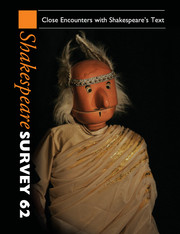Book contents
- Frontmatter
- Shakespeare, text and paratext
- The popularity of Shakespeare in print
- The continuing importance of new Bibliographical method
- ‘Honour the real thing’: Shakespeare, Trauma and Titus Andronicus in South Africa
- ‘O, these encounterers’: on Shakespeare’s meetings and partings
- A play of modals: Grammar and potential action in early Shakespeare
- Merry, marry, Mary: Shakespearian wordplay and Twelfth Night
- A subtle point: Sleeves, tents and ‘Ariachne’s broken woof’ (again)
- The look of Othello
- Red button Shakespeare
- ‘Mark you / his absolute shall?’: Multitudinous tongues and contested words in Coriolanus
- Chagall’s Tempest: An autobiographical reading
- Reading illustrated editions: Methodology and the limits of interpretation
- Close encounters with Anne Brontë's Shakespeare
- Shakespeare and the magic lantern
- Shakespeare and the coconuts: close encounters in post-apartheid South Africa
- The Schrödinger effect: Reading and misreading performance
- Behind the scenes
- Inner monologues: Realist acting and/as Shakespearian performance text
- More japanized, casual and transgender shakespeares
- Translation futures: Shakespearians and the foreign text
- After translation
- ‘The single and peculiar life’: Hamlet’s heart and the early modern subject
- Mapping King Lear
- ‘Last on the stage’: The place of Shakespeare in Charles Darwin’s ethology
- Sense/memory/sense-memory: Reading narratives of Shakespearian rehearsals
- Shakespeare performances in England (and Wales), 2008
- Professional Shakespeare productions in the British Isles, January–December 2007
- The Year's Contributions to Shakespearian Study 1 Critical Studies
- 2 Shakespeare in performance
- 3a Editions and textual studies
- 3b Editions and textual studies
- Index to Volume 62
Shakespeare, text and paratext
Published online by Cambridge University Press: 28 November 2009
- Frontmatter
- Shakespeare, text and paratext
- The popularity of Shakespeare in print
- The continuing importance of new Bibliographical method
- ‘Honour the real thing’: Shakespeare, Trauma and Titus Andronicus in South Africa
- ‘O, these encounterers’: on Shakespeare’s meetings and partings
- A play of modals: Grammar and potential action in early Shakespeare
- Merry, marry, Mary: Shakespearian wordplay and Twelfth Night
- A subtle point: Sleeves, tents and ‘Ariachne’s broken woof’ (again)
- The look of Othello
- Red button Shakespeare
- ‘Mark you / his absolute shall?’: Multitudinous tongues and contested words in Coriolanus
- Chagall’s Tempest: An autobiographical reading
- Reading illustrated editions: Methodology and the limits of interpretation
- Close encounters with Anne Brontë's Shakespeare
- Shakespeare and the magic lantern
- Shakespeare and the coconuts: close encounters in post-apartheid South Africa
- The Schrödinger effect: Reading and misreading performance
- Behind the scenes
- Inner monologues: Realist acting and/as Shakespearian performance text
- More japanized, casual and transgender shakespeares
- Translation futures: Shakespearians and the foreign text
- After translation
- ‘The single and peculiar life’: Hamlet’s heart and the early modern subject
- Mapping King Lear
- ‘Last on the stage’: The place of Shakespeare in Charles Darwin’s ethology
- Sense/memory/sense-memory: Reading narratives of Shakespearian rehearsals
- Shakespeare performances in England (and Wales), 2008
- Professional Shakespeare productions in the British Isles, January–December 2007
- The Year's Contributions to Shakespearian Study 1 Critical Studies
- 2 Shakespeare in performance
- 3a Editions and textual studies
- 3b Editions and textual studies
- Index to Volume 62
Summary
'Reader, . . . Introth you are a stranger tome; why should I Write to you? you neuer writ to mee.'
(Nathaniel Field, A Woman is a Weather-Cock, STC 10854, 1612, A3v)'To the onely rewarder, and most iust poiser of vertuous merits, the most honorably renowned No-body, bounteous Mecænas of Poetry, and Lord Protector of oppressed innocence.'
(John Marston, Antonio and Mellida, STC 17473, 1602, A2)The early modern dramatic paratext is a rich and varied repository of tributes to patrons and readers, where dramatists negotiated or parodied their attitudes towards dramatic publication and their reliance on the medium of print as a source of income and literary reputation. However, the lack of signed dedications or addresses to the reader in the early editions of Shakespeare's plays has deflected critical and editorial attention from early modern dramatic paratexts and from the significance of other paratextual features in Shakespeare, including title-pages, head titles, running titles and act and scene divisions. This article shows that a close analysis of some of these features and a contrastive analysis of Shakespearian and non-Shakespearian early modern playbooks lend fresh insight into what we mean by 'Shakespeare' and 'text' and how the texts of Shakespeare's plays are edited and re-presented to the modern reader.
Critical and editorial neglect of paratextual features in the early editions of Shakespeare's plays is also due to the enduring legacy of the New Bibliography. One crucial aspect of this legacy is the common tendency to identify the printer’s copy rather than the printed text as the ultimate source of textual authority. As a result, all those features that were added to the printer’s copy as the dramatic manuscript was transmitted into print and transformed into a reading text tend to be overlooked. The paradox of course is that no dramatic manuscripts used as printer’s copy to set up early modern playbooks have survived. Scholars interested in Shakespeare and performance often criticize the ‘tyranny of print’. Ironically, the study of Shakespeare in print has also been deeply affected by the ‘tyranny of the lost manuscript’. This understanding of the printed text as a misrepresentation of the printer’s copy, combined with the absence of any address or dedication signed by Shakespeare, has in turn led to a near-universal misconception of the paratext as marginal, dispensable, occasional, fundamentally different and ultimately detachable from the text.
- Type
- Chapter
- Information
- Shakespeare Survey , pp. 1 - 11Publisher: Cambridge University PressPrint publication year: 2009

